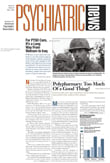The number of suicides in British prisons has increased in recent years. So Jenny Shaw, M.D., a psychiatrist with the University of Manchester’s Center for Suicide Prevention, and coworkers decided to conduct a study to obtain some insights into what drives British prisoners to suicide and what measures might be taken to prevent such acts.
The study period they focused on was 1999-2000, during which there were 172 prison suicides. The most common method of death was by hanging or self-strangulation—92 percent used this method—and 72 percent of these inmates had a history of at least one known mental disorder.
The most common ligature used for hanging was bedclothes (36 percent), and the main ligature points were window bars (48 percent); cell fittings such as lights, pipes, cupboards, sinks, toilets or doors (18 percent); or a bed (11 percent).
Less expectedly, however, the major psychiatric diagnosis of the prisoners who committed suicide was drug dependence; 27 percent of them had this disorder as a primary psychiatric diagnosis. The next most prevalent psychiatric diagnosis was affective disorder (18 percent), and then schizophrenia (6 percent).
The reason that so few suicide completers had a diagnosis of depression may have been “because depression is frequently overlooked in prisoners,” Shaw and her team suggested in their study report, which was published in the March British Medical Journal.
Also noteworthy, about a third of the suicides were found to occur within the first week of reception into prison. Early suicides were more common in drug-dependent prisoners; 59 percent of drug-dependent prisoners who died did so within seven days of reception.
There is reason to think that a disconnect between health services, and especially mental health services, and prisons may have contributed to some prison suicides, the researchers suggested. Although 70 percent of prisoners reported having a general practitioner prior to entering prison, the general practitioner was contacted for information by prison personnel in only 16 percent of cases, and in only 9 percent of cases was this within one week of reception.
Twenty-nine percent of prisoners reported upon entering prison that they had had contact with mental health services through Britain’s National Health Service, yet an attempt was made in only about one-third of these cases to obtain information from the service about the prisoner.
Shaw and her colleagues thus propose some measures that might help prevent suicides among British prisoners:
• Suicide prevention measures should be concentrated in the period immediately following reception into prison. For instance, following reception into prison, those thought to be at risk should be placed in a special prison wing where it is easier to monitor them.
• Detoxification facilities should be available to prisoners with a history of alcohol or drug abuse.
• When screening reveals that a prisoner has a history of contact with mental health services, relevant information should be obtained within 24 hours.
• High-risk prisoners should be put into cells without window bars and be given bed linen that cannot be used for hanging.
Interestingly, prison health care teams who were queried about how to reduce the incidence of prison suicides did not suggest limiting access to ligature points or means for hanging. However, they did make other suggestions, such as doing a better job of training staff in risk assessment and placing potential suicide attempters in a cell with another prisoner.
An abstract of the study, “Suicide by Prisoners,” is posted online at bjp.rcpsych.org/cgi/content/abstract/184/3/263. ▪
The British Journal of Psychiatry 2004 184 263
